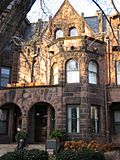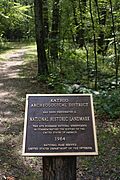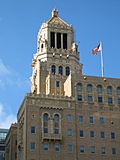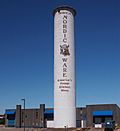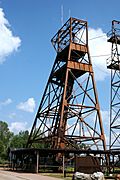List of National Historic Landmarks in Minnesota facts for kids
This is a complete List of National Historic Landmarks in Minnesota. The United States National Historic Landmark program is run by the National Park Service. It honors special places, buildings, objects, and areas that are important to the history of the whole country.
The state of Minnesota has 25 of these amazing landmarks. They show off Minnesota's Native American history, its industrial growth, logging, mining, military past, and political stories. They also show how the frontier was settled by European pioneers.
This article also lists other important historical places managed by the National Park Service.
Cool Historic Places in Minnesota
The table below lists all 25 of these special sites. It also gives you more details about each one.
| Landmark name | Image | Date designated | Location | County | Description | |
|---|---|---|---|---|---|---|
| 1 | Christ Church Lutheran |
(#01000654) |
Minneapolis 44°56′38″N 93°13′24″W / 44.94376°N 93.223208°W |
Hennepin | This church has a unique modern style. It was designed by a famous father and son team, Eliel Saarinen and Eero Saarinen. | |
| 2 | F. Scott Fitzgerald House |
(#71000440) |
Saint Paul 44°56′29″N 93°07′29″W / 44.9413805°N 93.1247305°W |
Ramsey | This was the home of Francis Scott Fitzgerald (1896–1940). He was a famous writer who wrote about the "Jazz Age." He wrote many stories and his first published novel, This Side of Paradise, here. This house is a Victorian rowhouse on Summit Avenue in Saint Paul. | |
| 3 | Fort Snelling |
(#66000401) |
Minneapolis 44°53′34″N 93°10′50″W / 44.892778°N 93.180556°W |
Hennepin | This used to be a military fort. It is located where the Minnesota and Mississippi Rivers meet. It is now part of the Mississippi National River and Recreation Area. | |
| 5 | James J. Hill House |
(#66000405) |
Saint Paul 44°56′42″N 93°06′32″W / 44.945111°N 93.108806°W |
Ramsey | This huge house was built by James J. Hill, a very rich railroad owner. It was finished in 1891. With 36,000 square feet (3,344 square meters), it is the largest home in Minnesota. | |
| 6 | Hull-Rust-Mahoning Open Pit Iron Mine |
(#66000904) |
Hibbing 47°27′N 92°57′W / 47.45°N 92.95°W |
St. Louis | This is the largest open pit iron mine in the world. It supplied a lot of iron ore for the United States during World War I and World War II. The town of Hibbing even had to move to make space for the mine to grow! | |
| 7 | Kathio Site |
(#66000403) |
Vineland 46°09′49″N 93°45′27″W / 46.163611°N 93.7575°W |
Mille Lacs | This area has old living sites and mound groups. They are believed to be from 3000 BC to 1750 AD. They show the history of Sioux and Ojibwe Native American cultures. It's now a state park with 19 important archaeological sites. | |
| 8 | Oliver H. Kelley Homestead |
(#66000406) |
Elk River 45°18′49″N 93°34′53″W / 45.313601°N 93.5814°W |
Sherburne | This farm was owned by Oliver Hudson Kelley. He was one of the people who started the Order of Patrons of Husbandry. This was a big organization for farmers. | |
| 9 | Frank B. Kellogg House |
(#74001035) |
Saint Paul 44°56′14″N 93°07′36″W / 44.937247°N 93.12661°W |
Ramsey | This was the home of Frank B. Kellogg (1856–1937) from 1889 until he passed away. He was a lawyer, a U.S. Senator, and a diplomat. As Secretary of State, he helped create the Kellogg-Briand Pact (1928). This pact was an agreement to avoid war. He won the Nobel Peace Prize for his work. | |
| 10 | Sinclair Lewis Boyhood Home |
(#68000027) |
Sauk Centre 45°44′14″N 94°57′25″W / 45.737128°N 94.956976°W |
Stearns | This was the home of Sinclair Lewis (1885–1951) from 1885 to 1902. He was the first American writer to win the Nobel Prize for literature (1930). His novel Main Street (1920) was partly based on his memories of Sauk Centre, Minnesota. | |
| 11 | Charles A. Lindbergh Sr. House |
(#70000303) |
Little Falls 45°57′27″N 94°23′23″W / 45.957439°N 94.389789°W |
Morrison | This used to be the farm of Congressman Charles August Lindbergh and his son, Charles Lindbergh. Charles Lindbergh was a very famous aviator (pilot). Their restored 1906 house is now part of a state park. | |
| 12 | Mayo Clinic Buildings |
(#69000075) |
Rochester 44°01′18″N 92°27′56″W / 44.021667°N 92.465556°W |
Olmsted | This building is a very important part of the Mayo Clinic. It was designed by Henry Stanley Plummer, who also helped start the Mayo Clinic. It was the tallest building in Rochester for many years. | |
| 13 | Mountain Iron Mine |
(#68000052) |
Mountain Iron 47°32′N 92°37′W / 47.54°N 92.62°W |
St. Louis | This mine was found in 1890. Its first shipment of iron ore was in 1892. This discovery showed that the Mesabi Range had the biggest iron ore deposits in the world. This made Minnesota the top supplier of iron in the nation. | |
| 14 | National Farmers Bank |
(#71000441) |
Owatonna 44°05′06″N 93°13′33″W / 44.0851°N 93.22575°W |
Steele | This bank building was designed by Louis Sullivan in 1908. It has red bricks with green decorative bands. Inside, it has a beautiful stained glass window and a mural. | |
| 15 | Peavey-Haglin Experimental Concrete Grain Elevator |
(#78001547) |
St. Louis Park 44°56′33″N 93°20′43″W / 44.9425°N 93.345278°W |
Hennepin | This grain elevator was built in 1899-1900. It was the first round concrete grain elevator in the United States, and maybe even the world! It proved that concrete was a good material for building grain elevators. Old ones made of wood were expensive and could catch fire easily. | |
| 16 | Pillsbury "A" Mill |
(#66000402) |
Minneapolis 44°59′02″N 93°15′10″W / 44.983939°N 93.252664°W |
Hennepin | This mill is located by Saint Anthony Falls on the Mississippi River. It was the largest flour mill in the world for 40 years! It was finished in 1881 and used very powerful waterwheels. The mill is still there today, but it stopped working in 2003. | |
| 17 | Rabideau CCC Camp |
(#76001046) |
Chippewa National Forest 47°38′24″N 94°32′55″W / 47.639986°N 94.548622°W |
Beltrami | This camp was built by the Civilian Conservation Corps (CCC) in the Chippewa National Forest. The CCC was a program started by President Franklin D. Roosevelt during the Great Depression. This camp gave jobs to about 300 young men. They worked on projects like building roads and protecting wildlife in the forest. | |
| 18 | O. E. Rolvaag House |
(#69000078) |
Northfield 44°27′48″N 93°10′20″W / 44.463206°N 93.172219°W |
Rice | This was the home of Ole Edvart Rølvaag (1876–1931) from 1912 until he passed away. He was a Norwegian immigrant and a writer. He wrote about the challenges pioneers faced when settling the frontier. His famous books include Giants in the Earth. | |
| 19 | St. Croix Boom Site |
(#66000407) |
Stillwater 45°04′41″N 92°47′53″W / 45.078°N 92.798°W |
Washington | This site is on the St. Croix River. It was used by lumber companies from Stillwater to manage logs floating down the river. It was very important for the logging industry in the area. | |
| 20 | St. Croix Recreational Demonstration Area |
(#97001261) |
Hinckley 46°00′41″N 92°56′40″W / 46.011389°N 92.944444°W |
Pine | This area was used for logging until about 1915. Later, the National Park Service and the Civilian Conservation Corps (CCC) turned it into a park. They built camps, roads, and campgrounds for people to enjoy. | |
| 21 | Soudan Iron Mine |
(#66000905) |
Tower 47°51′28″N 92°17′59″W / 47.857908°N 92.299611°W |
St. Louis | This is Minnesota's oldest, deepest, and richest iron mine. It started as an open pit mine in 1882. Later, it became an underground mine for safety. When it closed in 1962, it was very deep. Now, it's a state park and hosts a science lab underground. | |
| 22 | Split Rock Light Station |
(#69000073) |
Beaver Bay 47°12′00″N 91°22′01″W / 47.2°N 91.3669°W |
Lake | Split Rock Lighthouse is very important because it's a rare example of a complete lighthouse complex on the Great Lakes. Built from 1909-1910, it helped ships navigate on Lake Superior. It's now a historic site open to visitors. | |
| 23 | Thorstein Veblen Farmstead |
(#75001024) |
Nerstrand 44°21′N 93°03′W / 44.35°N 93.05°W |
Rice | This is the home and farm where Thorstein B. Veblen (1857–1929) grew up. He was a famous economist and social scientist. Many people call him one of America's most creative thinkers. | |
| 24 | Andrew John Volstead House |
(#74001046) |
Granite Falls 44°48′34″N 95°32′24″W / 44.809415°N 95.540020°W |
Yellow Medicine | This was the home of Andrew J. Volstead (1860–1947) from 1894 to 1930. He was a Congressman. He wrote a law called the National Prohibition Enforcement Act (1919), which became known as the Volstead Act. | |
| 25 | Washburn "A" Mill Complex |
(#83004388) |
Minneapolis 44°58′44″N 93°15′25″W / 44.978889°N 93.256944°W |
Hennepin | This mill was the second-largest flour mill in Minneapolis, Minnesota. The first mill here was built in 1874 but was destroyed in an explosion. It was rebuilt and became the most advanced and largest mill in the world for almost 50 years. Now, it's a museum called the Mill City Museum. |
Other Important Historic Sites
The National Park System also protects other historic places. These include National Historic Sites and National Monuments. They are already very protected and are important to the whole country. Two more Minnesota sites are National Monuments.
| Monument Name | Image | Established | Location | County | What Makes It Special | |
|---|---|---|---|---|---|---|
| 1 | Grand Portage National Monument | January 27, 1960 | Grand Portage 47°57′44″N 89°41′05″W / 47.962222°N 89.684722°W |
Cook | The Grand Portage National Monument is in the boreal forest near Lake Superior. It protects a very important place for the fur trade and the heritage of the Anishinaabeg Ojibwe people. | |
| 2 | Pipestone National Monument |  |
August 25, 1937 | Pipestone 44°00′48″N 96°19′31″W / 44.013333°N 96.325278°W |
Pipestone | Pipestone National Monument protects traditional catlinite quarries. Catlinite, or "pipestone," was used to make ceremonial pipes. These pipes are very important to traditional Plains Indian culture. The quarries are sacred to the Dakota Sioux Native Americans. All tribes could gather stone here for their pipes. |
Images for kids
See also



